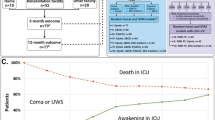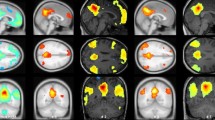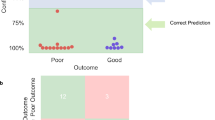Abstract
Objectives
Although laboratory parameters have long been recognized as indicators of outcome of traumatic brain injury (TBI), it remains a challenge to predict the recovery of disorder of consciousness (DOC) in severe brain injury including TBI. Recent advances have shown an association between alterations in brain connectivity and recovery from DOC. In the present study, we developed a prognostic model of DOC recovery via a combination of laboratory parameters and resting-state functional magnetic resonance imaging (fMRI).
Methods
Fifty-one patients with DOC (age = 52.3 ± 15.2 y, male/female = 31/20) were recruited from Hangzhou Hospital of Zhejiang CAPR and were sub-grouped into conscious (n = 34) and unconscious (n = 17) groups based upon their Glasgow Outcome Scale-Extended (GOS-E) scores at 12-month follow-ups after injury. Resting-state functional connectivity, network nodal measures (centrality), and laboratory parameters were obtained from each patient and served as features for support vector machine (SVM) classifications.
Results
We found that functional connectivity was the most accurate single-domain model (ACC: 70.1% ± 4.5%, P = 0.038, 1000 permutations), followed by degree centrality, betweenness centrality, and laboratory parameters. The stacked multi-domain prognostic model (ACC: 73.4% ± 3.1%, P = 0.005, 1000 permutations) combining all single-domain models yielded a significantly higher accuracy compared to that of the best-performing single-domain model (P = 0.002).
Conclusion
Our results suggest that laboratory parameters only contribute to the outcome prediction of DOC patients, whereas combining information from neuroimaging and clinical parameters may represent a strategy to achieve a more accurate prognostic model, which may further provide better guidance for clinical management of DOC patients.





Similar content being viewed by others
References
Achard, S., Delon-Martin, C., Vértes, P. E., Renard, F., Schenck, M., Schneider, F., Heinrich, C., Kremer, S., & Bullmore, E. T. (2012). Hubs of brain functional networks are radically reorganized in comatose patients. Proceedings National Academy of Sciences United States of America, 109(50), 20608–20613. https://doi.org/10.1073/pnas.1208933109.
Al-Mufti, F., Amuluru, K., Damodara, N., Dodson, V., Roh, D., Agarwal, S., Meyers, P. M., Connolly, E. S., Schmidt, M. J., Claassen, J., & Park, S. (2019). Admission neutrophil-lymphocyte ratio predicts delayed cerebral ischemia following aneurysmal subarachnoid hemorrhage. The Journal of NeuroInterventional Surgery, 11(11), 1135–1140. https://doi.org/10.1136/neurintsurg-2019-014759.
Ashburner, J. (2007). A fast diffeomorphic image registration algorithm. NeuroImage, 38(1), 95–113. https://doi.org/10.1016/j.neuroimage.2007.07.007.
Bernat, J. L. (2006). Chronic disorders of consciousness. The Lancet, 367(9517), 1181–1192. https://doi.org/10.1016/s0140-6736(06)68508-5.
Chennu, S., Annen, J., Wannez, S., Thibaut, A., Chatelle, C., Cassol, H., Martens, G., Schnakers, C., Gosseries, O., Menon, D., & Laureys, S. (2017). Brain networks predict metabolism, diagnosis and prognosis at the bedside in disorders of consciousness. Brain, 140(8), 2120–2132. https://doi.org/10.1093/brain/awx163.
Crone, J. S., Soddu, A., Holler, Y., Vanhaudenhuyse, A., Schurz, M., Bergmann, J., Schmid, E., Trinka, E., Laureys, S., & Kronbichler, M. (2014). Altered network properties of the fronto-parietal network and the thalamus in impaired consciousness. NeuroImage: Clinical, 4, 240–248. https://doi.org/10.1016/j.nicl.2013.12.005.
Dai, Z., Yan, C., Li, K., Wang, Z., Wang, J., Cao, M., Lin, Q., Shu, N., Xia, M., Bi, Y., & He, Y. (2015). Identifying and mapping connectivity patterns of brain network hubs in Alzheimer’s disease. Cerebral Cortex, 25(10), 3723–3742. https://doi.org/10.1093/cercor/bhu246.
Demertzi, A., Soddu, A., & Laureys, S. (2013). Consciousness supporting networks. Current Opinion in Neurobiology, 23(2), 239–244. https://doi.org/10.1016/j.conb.2012.12.003.
Di Perri, C., Bastianello, S., Bartsch, A. J., Pistarini, C., Maggioni, G., Magrassi, L., Imberti, R., Pichiecchio, A., Vitali, P., Laureys, S., & Di Salle, F. (2013). Limbic hyperconnectivity in the vegetative state. Neurology, 81(16), 1417–1424. https://doi.org/10.1212/WNL.0b013e3182a43b78.
Di Perri, C., Bahri, M. A., Amico, E., Thibaut, A., Heine, L., Antonopoulos, G., Charland-Verville, V., Wannez, S., Gomez, F., Hustinx, R., Tshibanda, L., Demertzi, A., Soddu, A., & Laureys, S. (2016). Neural correlates of consciousness in patients who have emerged from a minimally conscious state: A cross-sectional multimodal imaging study. The Lancet Neurology, 15(8), 830–842. https://doi.org/10.1016/s1474-4422(16)00111-3.
Dresler, M., Shirer, W. R., Konrad, B. N., Müller, N. C. J., Wagner, I. C., Fernández, G., Czisch, M., & Greicius, M. D. (2017). Mnemonic training reshapes brain networks to support superior memory. Neuron, 93(5), 1227–1235.e6. https://doi.org/10.1016/j.neuron.2017.02.003.
Edelman, G. M. (2003). Naturalizing consciousness: A theoretical framework. Proceedings National Academy of Sciences United States of America, 100(9), 5520–5524. https://doi.org/10.1073/pnas.0931349100.
Fan, L., Li, H., Zhuo, J., Zhang, Y., Wang, J., Chen, L., Yang, Z., Chu, C., Xie, S., Laird, A. R., Fox, P. T., Eickhoff, S. B., Yu, C., & Jiang, T. (2016). The human Brainnetome atlas: A new brain atlas based on connectional architecture. Cerebral Cortex, 26(8), 3508–3526. https://doi.org/10.1093/cercor/bhw157.
Giacino, J. T., Ashwal, S., Childs, N., Cranford, R., Jennett, B., Katz, D. I., Kelly, J. P., Rosenberg, J. H., Whyte, J., Zafonte, R. D., & Zasler, N. D. (2002). The minimally conscious state: Definition and diagnostic criteria. Neurology, 58(3), 349–353. https://doi.org/10.1212/WNL.58.3.349.
Giacino, J. T., Kalmar, K., & Whyte, J. (2004). The JFK coma recovery scale-revised: Measurement characteristics and diagnostic utility. Archives of Physical Medicine and Rehabilitation, 85(12), 2020–2029. https://doi.org/10.1016/j.apmr.2004.02.033.
Greuters, S., van den Berg, A., Franschman, G., Viersen, V. A., Beishuizen, A., Peerdeman, S. M., & Boer, C. (2011). Acute and delayed mild coagulopathy are related to outcome in patients with isolated traumatic brain injury. Critical Care, 15(1), R2. https://doi.org/10.1186/cc9399.
van den Heuvel, M. P., & Fornito, A. (2014). Brain networks in schizophrenia. Neuropsychology Review, 24(1), 32–48. https://doi.org/10.1007/s11065-014-9248-7.
Jenkinson, M., Bannister, P., Brady, M., & Smith, S. (2002). Improved optimization for the robust and accurate linear registration and motion correction of brain images. Neuroimage, 17(2), 825–841. https://doi.org/10.1006/nimg.2002.1132.
Jennett, B., Snoek, J., Bond, M. R., & Brooks, N. (1981). Disability after severe head injury: Observations on the use of the Glasgow outcome scale. Journal of Neurology, Neurosurgery, and Psychiatry, 44(4), 285–293.
Jeremitsky, E., Omert, L. A., Dunham, C. M., Wilberger, J., & Rodriguez, A. (2005). The impact of hyperglycemia on patients with severe brain injury. The Journal of Trauma, 58(1), 47–50. https://doi.org/10.1097/01.ta.0000135158.42242.b1.
Kim, J., & Hashim, I. A. (2016). The clinical utility of CK-MB measurement in patients suspected of acute coronary syndrome. Clinica Chimica Acta, 456, 89–92. https://doi.org/10.1016/j.cca.2016.02.030.
Laureys, S., & Boly, M. (2007). What is it like to be vegetative or minimally conscious? Current Opinion in Neurology, 20(6), 609–613. https://doi.org/10.1097/WCO.0b013e3282f1d6dd.
Liu, X., Li, J., Gao, J., Zhou, Z., Meng, F., Pan, G., & Luo, B. (2017). Association of medial prefrontal cortex connectivity with consciousness level and its outcome in patients with acquired brain injury. Journal of Clinical Neuroscience, 42, 160–166. https://doi.org/10.1016/j.jocn.2017.04.015.
Matsuo, K., Aihara, H., Nakai, T., Morishita, A., Tohma, Y., & Kohmura, E. (2019). Machine learning to predict in-hospital morbidity and mortality after traumatic brain injury. Journal of Neurotrauma, 37, 202–210. https://doi.org/10.1089/neu.2018.6276.
Montalcini, T., Moraca, M., Ferro, Y., Romeo, S., Serra, S., Raso, M. G., Rossi, F., Sannita, W. G., Dolce, G., & Pujia, A. (2015). Nutritional parameters predicting pressure ulcers and short-term mortality in patients with minimal conscious state as a result of traumatic and non-traumatic acquired brain injury. Journal of Translational Medicine, 13, 305. https://doi.org/10.1186/s12967-015-0660-4.
Mushkudiani, N. A., Engel, D. C., Steyerberg, E. W., Butcher, I., Lu, J., Marmarou, A., Slieker, F., McHugh, G. S., Murray, G. D., & Maas, A. I. (2007). Prognostic value of demographic characteristics in traumatic brain injury: Results from the IMPACT study. Journal of Neurotrauma, 24(2), 259–269. https://doi.org/10.1089/neu.2006.0028.
Nelson, D. W., Rudehill, A., MacCallum, R. M., Holst, A., Wanecek, M., Weitzberg, E., & Bellander, B. M. (2012). Multivariate outcome prediction in traumatic brain injury with focus on laboratory values. Journal of Neurotrauma, 29(17), 2613–2624. https://doi.org/10.1089/neu.2012.2468.
Norton, L., Hutchison, R. M., Young, G. B., Lee, D. H., Sharpe, M. D., & Mirsattari, S. M. (2012). Disruptions of functional connectivity in the default mode network of comatose patients. Neurology, 78(3), 175–181. https://doi.org/10.1212/WNL.0b013e31823fcd61.
Oddo, M., Levine, J. M., Kumar, M., Iglesias, K., Frangos, S., Maloney-Wilensky, E., & Le Roux, P. D. (2012). Anemia and brain oxygen after severe traumatic brain injury. Intensive Care Medicine, 38(9), 1497–1504. https://doi.org/10.1007/s00134-012-2593-1.
Pistoia, F., Sacco, S., Franceschini, M., Sara, M., Pistarini, C., Cazzulani, B., Simonelli, I., Pasqualetti, P., & Carolei, A. (2015). Comorbidities: A key issue in patients with disorders of consciousness. Journal of Neurotrauma, 32(10), 682–688. https://doi.org/10.1089/neu.2014.3659.
Pustina, D., Coslett, H. B., Ungar, L., Faseyitan, O. K., Medaglia, J. D., Avants, B., & Schwartz, M. F. (2017). Enhanced estimations of post-stroke aphasia severity using stacked multimodal predictions. Human Brain Mapping, 38(11), 5603–5615. https://doi.org/10.1002/hbm.23752.
Qin, P., Wu, X., Huang, Z., Duncan, N. W., Tang, W., Wolff, A., Hu, J., Gao, L., Jin, Y., Wu, X., Zhang, J., Lu, L., Wu, C., Qu, X., Mao, Y., Weng, X., Zhang, J., & Northoff, G. (2015). How are different neural networks related to consciousness? Annals of Neurology, 78(4), 594–605. https://doi.org/10.1002/ana.24479.
Schnakers, C., Vanhaudenhuyse, A., Giacino, J., Ventura, M., Boly, M., Majerus, S., Moonen, G., & Laureys, S. (2009). Diagnostic accuracy of the vegetative and minimally conscious state: Clinical consensus versus standardized neurobehavioral assessment. BMC Neurology, 9, 35. https://doi.org/10.1186/1471-2377-9-35.
Sidaros, A., Engberg, A. W., Sidaros, K., Liptrot, M. G., Herning, M., Petersen, P., Paulson, O. B., Jernigan, T. L., & Rostrup, E. (2008). Diffusion tensor imaging during recovery from severe traumatic brain injury and relation to clinical outcome: A longitudinal study. Brain, 131(Pt 2), 559–572. https://doi.org/10.1093/brain/awm294.
Silva, S., de Pasquale, F., Vuillaume, C., Riu, B., Loubinoux, I., Geeraerts, T., Seguin, T., Bounes, V., Fourcade, O., Demonet, J. F., & Péran, P. (2015). Disruption of posteromedial large-scale neural communication predicts recovery from coma. Neurology, 85(23), 2036–2044. https://doi.org/10.1212/wnl.0000000000002196.
Siwicka-Gieroba, D., Malodobry, K., Biernawska, J., Robba, C., Bohatyrewicz, R., Rola, R., & Dabrowski, W. (2019). The neutrophil/lymphocyte count ratio predicts mortality in severe traumatic brain injury patients. Journal of Clinical Medicine, 8(9), 1453. https://doi.org/10.3390/jcm8091453.
Song, M., Yang, Y., He, J., Yang, Z., Yu, S., Xie, Q., Xia, X., Dang, Y., Zhang, Q., Wu, X., Cui, Y., Hou, B., Yu, R., Xu, R., & Jiang, T. (2018). Prognostication of chronic disorders of consciousness using brain functional networks and clinical characteristics. Elife, 7, e36173. https://doi.org/10.7554/eLife.36173.
Stender, J., Gosseries, O., Bruno, M. A., Charland-Verville, V., Vanhaudenhuyse, A., Demertzi, A., Chatelle, C., Thonnard, M., Thibaut, A., Heine, L., Soddu, A., Boly, M., Schnakers, C., Gjedde, A., & Laureys, S. (2014). Diagnostic precision of PET imaging and functional MRI in disorders of consciousness: A clinical validation study. The Lancet, 384(9942), 514–522. https://doi.org/10.1016/S0140-6736(14)60042-8.
Stevens, R. D., & Sutter, R. (2013). Prognosis in severe brain injury. Critical Care Medicine, 41(4), 1104–1123. https://doi.org/10.1097/CCM.0b013e318287ee79.
Teasdale, G. M., Pettigrew, L. E., Wilson, J. T., Murray, G., & Jennett, B. (1998). Analyzing outcome of treatment of severe head injury: A review and update on advancing the use of the Glasgow outcome scale. Journal of Neurotrauma, 15(8), 587–597. https://doi.org/10.1089/neu.1998.15.587.
Tzourio-Mazoyer, N., Landeau, B., Papathanassiou, D., Crivello, F., Etard, O., Delcroix, N., Mazoyer, B., & Joliot, M. (2002). Automated anatomical labeling of activations in SPM using a macroscopic anatomical parcellation of the MNI MRI single-subject brain. NeuroImage, 15(1), 273–289.
Van Beek, J. G., Mushkudiani, N. A., Steyerberg, E. W., Butcher, I., McHugh, G. S., Lu, J., Marmarou, A., Murray, G. D., & Maas, A. I. (2007). Prognostic value of admission laboratory parameters in traumatic brain injury: Results from the IMPACT study. Journal of Neurotrauma, 24(2), 315–328. https://doi.org/10.1089/neu.2006.0034.
Vanhaudenhuyse, A., Noirhomme, Q., Tshibanda, L. J., Bruno, M. A., Boveroux, P., Schnakers, C., Soddu, A., Perlbarg, V., Ledoux, D., Brichant, J. F., Moonen, G., Maquet, P., Greicius, M. D., Laureys, S., & Boly, M. (2010). Default network connectivity reflects the level of consciousness in non-communicative brain-damaged patients. Brain, 133(Pt 1), 161–171. https://doi.org/10.1093/brain/awp313.
Wang, J., Wang, X., Xia, M., Liao, X., Evans, A., & He, Y. (2015). GRETNA: A graph theoretical network analysis toolbox for imaging connectomics. Frontiers in Human Neuroscience, 9(386). https://doi.org/10.3389/fnhum.2015.00386.
Wilson, J. T. L., Edwards, P., Fiddes, H., Stewart, E., & Teasdale, G. M. (2002). Reliability of postal questionnaires for the Glasgow outcome scale. Journal of Neurotrauma, 19(9), 999–1005.
Wu, X., Zou, Q., Hu, J., Tang, W., Mao, Y., Gao, L., Zhu, J., Jin, Y., Wu, X., Lu, L., Zhang, Y., Zhang, Y., Dai, Z., Gao, J. H., Weng, X., Zhou, L., Northoff, G., Giacino, J. T., He, Y., & Yang, Y. (2015). Intrinsic functional connectivity patterns predict consciousness level and recovery outcome in acquired brain injury. The Journal of Neuroscience, 35(37), 12932–12946. https://doi.org/10.1523/JNEUROSCI.0415-15.2015.
Yan, C. G., Wang, X. D., Zuo, X. N., & Zang, Y. F. (2016). DPABI: Data processing & analysis for (resting-state) brain imaging. Neuroinformatics, 14, 339–351. https://doi.org/10.1007/s12021-016-9299-4.
Zhang, J., Ren, Q., Song, Y., He, M., Zeng, Y., Liu, Z., & Xu, J. (2017). Prognostic role of neutrophil-lymphocyte ratio in patients with acute ischemic stroke. Medicine (Baltimore), 96(45), e8624. https://doi.org/10.1097/md.0000000000008624.
Zhang, L., Luo, L., Zhou, Z., Xu, K., Zhang, L., Liu, X., Tan, X., Zhang, J., Ye, X., Gao, J., & Luo, B. (2018). Functional connectivity of anterior insula predicts recovery of patients with disorders of consciousness. Frontiers in Neurology, 9, 1024. https://doi.org/10.3389/fneur.2018.01024.
Zheng, J., Zheng, H., Gupta, R. K., Li, H., Shi, H., Pan, L., Gong, S., & Liang, H. (2017). Interrelationship of rotavirus infection and creatine kinase-MB isoenzyme levels in children hospitalized with acute gastroenteritis in Guangzhou, China, 2012–2015. Scientific Reports, 7(1), 7674. https://doi.org/10.1038/s41598-017-07636-4.
Funding
This article was supported by grants from the National Natural Science Foundation of China (81870817), National Key R&D Program of China (2018YFA0701400), and the Fundamental Research Funds for the Central Universities +2019-XZZX-001-01-02. Y. S. was additionally supported by the National Natural Science Foundation of China (81801785) and the Fundamental Research Funds for the Central Universities (2019FZJD005, 2020FZZX001-05).
Author information
Authors and Affiliations
Corresponding authors
Ethics declarations
This study was approved by the Ethics Committee of the First Affiliated Hospital within the School of Medicine at Zhejiang University, and written informed consents in accordance with the Declaration of Helsinki were obtained from the legal guardians of the included patients.
Conflict of interest
The authors declare that they have no conflict of interest.
Additional information
Publisher’s note
Springer Nature remains neutral with regard to jurisdictional claims in published maps and institutional affiliations.
Electronic supplementary material
ESM 1
(DOCX 944 kb)
Rights and permissions
About this article
Cite this article
Yu, Y., Meng, F., Zhang, L. et al. A multi-domain prognostic model of disorder of consciousness using resting-state fMRI and laboratory parameters. Brain Imaging and Behavior 15, 1966–1976 (2021). https://doi.org/10.1007/s11682-020-00390-8
Accepted:
Published:
Issue Date:
DOI: https://doi.org/10.1007/s11682-020-00390-8




